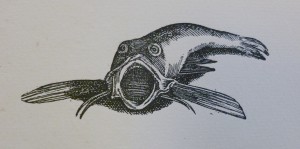September 19, 2016, by Kathryn Steenson
Pirates!
Ahoy there readers! No, this is not a post about digital piracy or illegal file sharing, but the sea-faring pirates of old, to mark that most frivolous of parody holidays, International Talk Like A Pirate Day.
Originally started in America as an in-joke between friends, it has become an annual charity fundraising day, where participants are sponsored to dress and/or talk like a pirate for a day, or host pirate-themed events. Admittedly, the University Special Collections of a land-locked county is not everyone’s first place to look for material relating to the high seas. It was only by accident that I stumbled across this book, Real Sailor Songs, collected and edited by John Ashton, 1891 (Ref: Special Collection Oversize PR1188.R4) when looking for something else.
The book contains reprints of 129 broadside ballads accompanied by 200 illustrations. There is no musical notation, and it’s not always apparent to what tune the words are supposed to be sung. They cover a wide range of subjects: life at sea, British naval victories, shipwrecks and disasters, and lamentations at leaving loved ones ashore – and, of course, pirates. As the photos show, an eclectic mix of images accompany the lyrics. Every page has a different style, font and layout – perhaps the grog was imbibed a little too enthusiastically during the process – but there is something quite charming about the randomness of this volume. The preface opens by declaring that:
“The days of real sailor songs are long since past and gone. They died out with the old French war, and its consequent peace…They are dead, and the songs sung by sailors now-a-days, come direct from the Music Halls. Except in the Navy, there are no long cruises, and the short voyages enable seafarers to keep themselves au courant with the last thing out in Songs…But the old ones occupy a position all their own…They were sung equally in the Forecastle and the Ward Room, and many of those I have selected bear internal evidence of the poetic genius of both places.”

From a selection of 200 illustrations, this is the one picked to accompany a ballad about a young woman mourning the loss of her sailor sweetheart.
The motivation for collecting them was a desire to preserve the dying tradition. Some of the songs date back to the 17th century and Ashton seems to have made an effort to authenticate them. He recognised that some of them might need explaining for the landlubbers amongst the readers, as a few of the battle songs have a short preface, indicating that it was already passing out of popular memory.
One of the longest author’s notes is about ‘The Downfall of Piracy’. Ashton neglects to credit any of the songs, but this one was probably written circa 1719 by Benjamin Franklin, later a Founding Father of America but then a teenaged printer’s apprentice. Neither Franklin nor Ashton (nor the organisers of ITLAPD, for that matter) romanticized pirates, and Ashton in particular was quite keen to let the readers know just how barbaric and reprehensible real pirates were:
“This notorious villain, Edward Teach, alias Blackbeard, was born at Bristol at the end of the 17th Century: and he seems to have commenced his piratical career with the pirate Hornigold. Teach was, perhaps, one of the most brutal of all the celebrated pirates; indeed he wished to be thought a very devil incarnate. It is told of him that, one day, being mad drunk, he called to his crew “Come lads, let’s make a Hell of our own, and see how long we can bear it.” So some of them went with him below, and, closing the hatches, filled several pots with brimstone [sulfur] and other evil smelling things, which they set on fire, remaining until they were nearly suffocated, and cried out for air, when he opened the hatches, pleased that he could hold out the longest.
The ballad is trustworthy in its history, even to Teach’s drinking a glass of wine, and its accompanying speech, He was deservedly killed in action on 21st November 1717. Captain Maynard had the wretch’s head cut off and hung to his bowsprit, and after shewing it at Bath town he sailed with it to the Men of War in James’ river.”
Visit the website of the British branch of ITLAPD to find out more about it. For more information about Manuscripts & Special Collections, including our holdings and how you can access them, visit our website or follow us on Twitter @mssUniNott.
No comments yet, fill out a comment to be the first





Leave a Reply